|
Monday, March 22, 2010
Progress Notes
One of the most knowledgeable people about Miller County I know is Mike Wieneman (photo 01), originally from Eldon now living in Springfield, Missouri.

01 Mike Wieneman From the beginning when we began our website Mike has generously shared information and photographs with us. He has one of the largest historical photograph collections of Miller County of which I am aware. Mike was the one the Bagnell Dam 50th Anniversary committee called upon to supply it with old Tuscumbia photographs for its book of the history of the Lake area. Mike has familial connections with many Miller County family names including Vaughan, Kelsey, Scott, Harrison (Tuscumbia), and Palmer. Thomas Scott, one of only five Miller County State Senators, was Mike’s second great grandfather. Also, Mike was a charter member of the Miller County Historical Society.
One of the names he has as part of his heritage is that of the Clark family. I asked him if he would share his history of the Miller County Clark family with us. Mike was careful to inform me that his Clark family is separate from the Clark family south of the river.
First, Mike presented me with a short synopsis of his family roots along with photographs. Then, in a second narrative, he describes in more detail some of the interesting facts about the family. Here is the first narrative:
My Clark Ancestors
Mike Wieneman
- George Clark was my great-great-grandfather (photo 02).
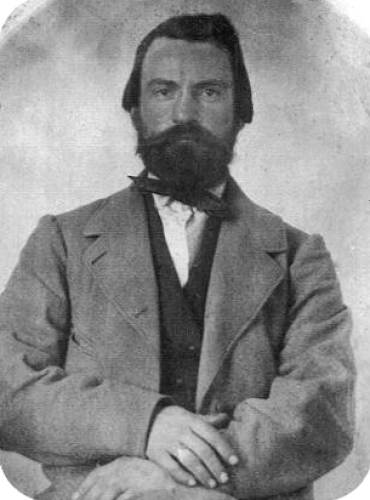
02 George Clark
He was born June 15, 1813 in Washington County, Virginia and died February 5, 1892 in Eldon, Miller County, Missouri. He married January 28, 1836 in Washington County, Virginia to my great-great grandmother Mary Barker (photo 03).
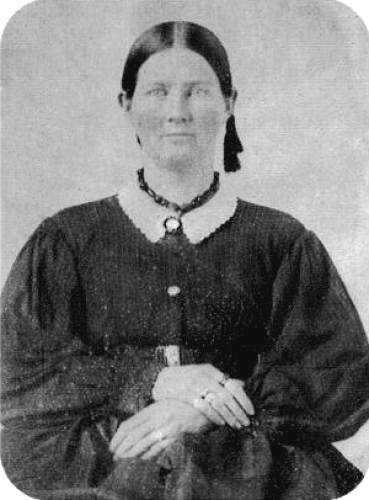
03 Mary (Barker) Clark
She was born May 21, 1810 in Washington County, Virginia and died June 15, 1868 in Miller County, Missouri. They are buried in the Salem Cemetery near Eldon, Miller County, Missouri. They were the parents of 7 children. The children were: William G., Joel barker, Catherine E., Rebecca J., Edward Lewis, James, and George H.
- William G. Clark was my great-grandfather (photo 04).
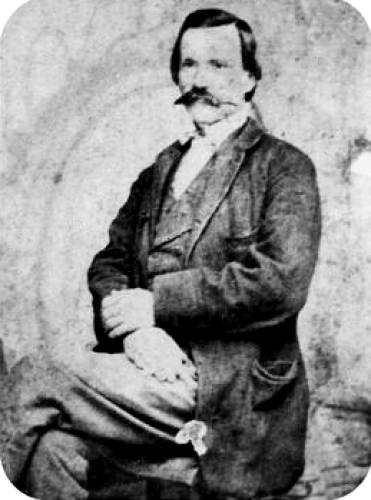
04 William G. Clark
He was born October 20, 1837 in Abingdon, Washington County, Virginia and died October 8, 1905 in Tuscumbia, Miller County, Missouri. He married July 3, 1856 near High Point, Moniteau County, Missouri to my great-grandmother Margaret Kelsay (photo 05).
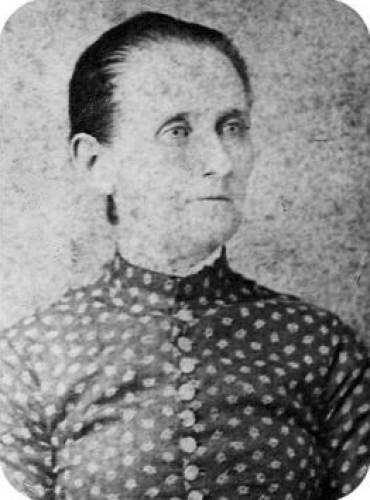
05 Margaret (Kelsay) Clark
She was born January 5, 1838 in Morgan County, Missouri and died November 18, 1910 in Tuscumbia, Miller County, Missouri. They are buried in the Tuscumbia Cemetery, Tuscumbia, Miller County, Missouri. They were the parents of 10 children. The children were: George W., William G., John Charles Fremont, Virginia Belle, Mary Annie, Thomas, Josie Lou, Martha Jane, Lucy Ellen Olive, and Edward Pinkney.
- George W. Clark was my grandfather (photo 06).

06 George Clark - Husband of Lena Scott
He was born August 8, 1858 near California, Moniteau County, Missouri and died March 21, 1920 in Tuscumbia, Miller County, Missouri. He married May 5, 1901 in Tuscumbia, Miller County, Missouri to my grandmother Lena Alice Scott (photo 07).
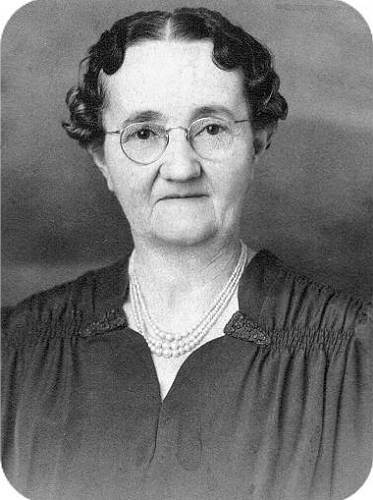
07 Lena (Scott) Clark
She was born January 28, 1884 in Tuscumbia, Miller County, Missouri and died October 14, 1958 in Tuscumbia, Miller County, Missouri. George Clark is buried in the Tuscumbia Cemetery, Tuscumbia, Miller County, Missouri. Lena Alice is buried in the Eldon Cemetery, Eldon, Miller County, Missouri. They were the parents of 5 children. The children were: Oma Audra, George Albert, Lucy Helen, Frank Riley, and Irene Elizabeth.
- Irene Elizabeth Clark was my mother. She married my father Bernard Philip Wieneman (photo 07a).
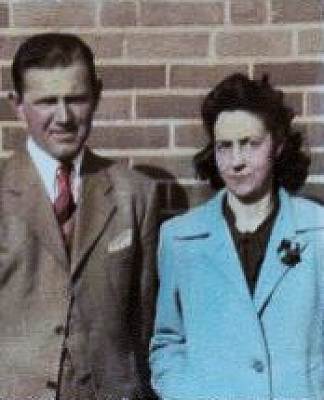
07a Bernard and Elizabeth (Clark) Wieneman
My mother was born July 29, 1915 in Tuscumbia, Miller County, Missouri and died November 22, 1969 in Columbia, Boone County, Missouri. She married February 13, 1934 in Jefferson City, Cole County, Missouri to my father Bernard Philip Wieneman. He was born August 9, 1911 in Wakefield, Dixon County, Nebraska and died November 4, 1975 in Eldon, Miller County, Missouri. Both are buried in the Eldon Cemetery, Eldon, Miller County, Missouri. They were the parents of 3 children. The names of the children are: Robert Eugene, Jean Elsie, and Michael Lee.
- I was born Michael Lee Wieneman on February 10, 1955 in Eldon, Miller County, Missouri. I am not married.
The next section of Mike’s history of the Clark family contains more historical detail. You can refer to the above synopsis to review the photos once again as Mike refers to them in the second narrative below:
Clark Family History
By Mike Wieneman
George and Mary (Barker) Clark resided in Washington County Virginia until about 1845. Nothing is known of his boyhood except that he was reared in the county of his birth and received some form of education. The Clark farm was near Abingdon Virginia. Their first four children, William G., Joel B., Catherine E., and Rebecca J. were born in Washington County. The family removed to Sullivan County Tennessee where three more children were born, namely, Edward L., James and George H. After a brief residence in Tennessee the Clark family came to Missouri in 1850 settling in Warren County. Sometime between the years 1850 and 1856 the family settled in Moniteau County near the important trading center town of California. Farm land was purchased there. The route they took is unknown but they traveled in a covered wagon drawn by a team of fine horses. They had extra horses and the two older boys William G. and Joel B. rode horseback or walked whenever it suited their pleasure. Mr. Clark, being a farmer as well as a blacksmith, needed land for his former occupation yet close enough to a town for the successful operation of his blacksmith trade. The children received their formal education at subscription schools and at home from their parents. In 1860 George and Mary Clark purchased a 96 acre farm north and west of Eldon in Miller County from F.O. Andrews, and the family moved to this farm.
Other farms were purchased in the area upon which William G. and Joel B. resided with their families. William G. Clark married Margaret Kelsay in Moniteau County. Joel B. Clark married Eliza Erwin in Miller County. Both William G. and Joel B. served with the Union Army during the Civil War. Catherine Clark married William Anderson Allen and they removed to the State of Texas where Mr. Allen served with the Confederate Army. After the war they returned to Missouri residing first in Moniteau County then in Miller County. Rebecca Clark married Isaac Large. They are buried in the Salem Cemetery one mile north of Eldon. Edward L. Clark went to Indian territory where he became an interpreter, a Sub-Agent, and a dispenser of medicine at the Indian reservation, Fort Sill, Indian territory. He married the Comanche Indian girl Wau-ma-co-nie. Both are buried on the Indian Reservation. No record has been found of James Clark after the 1860 Federal census. Much conflicting information has been given on the son George H. Clark. It is known that he was living on the farm with his father in 1880. There is a record of his having worked in the Post Traders Store in Fort Sill where he went after the death of his father in 1892. It is family tradition that he married Sarah Lawson an Indian girl and that he died in Oklahoma. Joel B. Clark and his wife Eliza are buried in the Salem cemetery. William G. Clark and his wife Margaret are buried in the Tuscumbia Cemetery. George and Mary (Barker) Clark are buried in the Salem Cemetery. Mr. Clark’s grave is not marked.
Mike’s Clark family members were quite involved with the functions of the governance of the county in the late 1800’s and early 1900’s. For example, in this photo of the county court taken in or about 1901, William “Billy” Clark, Mike’s great grandfather, is standing on the far left of the back row (photo 08).
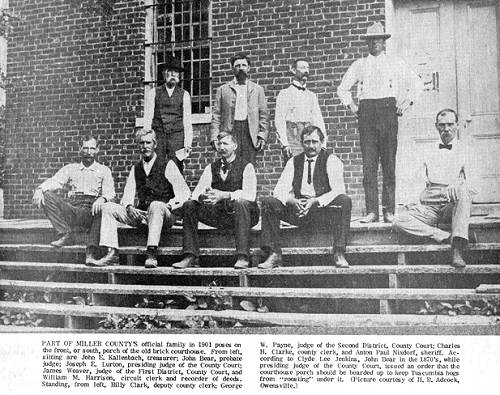
08 County Officials - 1901
Click image for larger viewAlso, further to the right is Charles Clarke, an Englishman who was not blood related to Mike, but was related by marriage. Here’s how Mike explains it:
Billy Clark was my great-grandfather. His real name was William G. Clark. Charles Clarke was his son-in-law (photo 09).
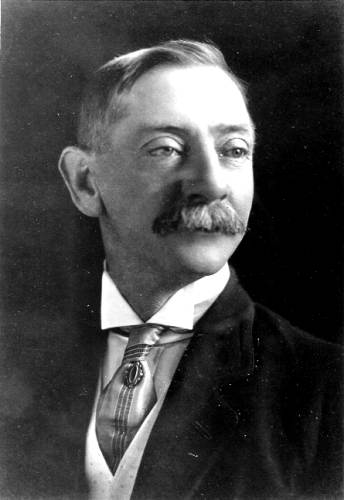
09 Charles Clarke My great-uncle Charley Clarke came from England as a stow-a-way but was my great-uncle by marriage to my grandfather's sister Aunt Mattie Clark. Both had the name Clark, however they were not related until they got married. Charley's first wife Belle Skinner, daughter of Jim Skinner, died in childbirth. Charley and she were the parents of Louie (Clarke) Lawson (photo 10).
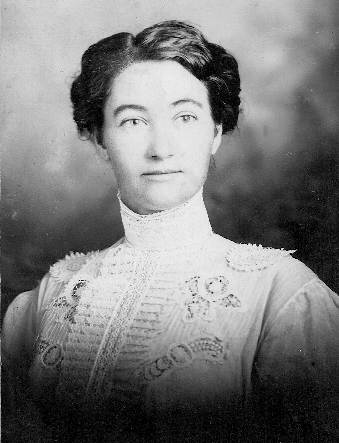
10 Louie (Clarke) Lawson I knew her quite well. My mother was named for her, although she never used the name "Louie". I always considered Louie as a cousin of mine. Uncle Charley was always called "London Charley" by everyone who knew him. Louie was married to Claude Lawson (photo 11).
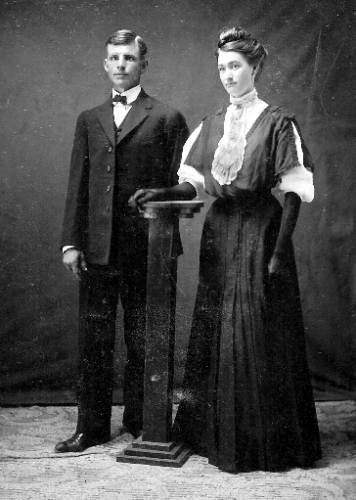
11 Claude and Louie Lawson My mother lived neighbors to Claude and Louie when she was born in 1915. This was on the Tuscumbia river road up the river from town. Mother’s two houses got flooded away during the 1940's. One wood frame house and one log house were taken. Her given name was Elizabeth Clark, a daughter of George and Lena (Scott) Clark.
Note: you can read more about the flood which swept away the two buildings of Elizabeth Clark on the recent Progress Notes of March 8, 2010.
The Lawson school was named for Claude and Louie. My mother’s older brothers and sisters attended that school.
As noted above, Louie Lawson's father Charles Henry Clarke was my mother’s uncle by marriage.
I remember stories about Jim Skinner from people years ago. They said that after he made his own coffin he laid down in it to make sure that he liked it and that it would fit him. Also he told people that he wanted to be buried above the ground so that the devil couldn't get him! He came to Eldon driving a buck board wagon. A former boss of mine said that his little dog would jump on the seat next to Jim on his wagon and would ride with him.
You can read more about Charles Clarke, Louie and Jim Skinner at this previous Progress Notes.
Another Clark relative of Mike’s was Edward P. Clark, who was the brother of Mike’s grandfather, George W. Clark. Edward served on the County Court in 1909 as is shown in this photo where he is standing on the far left (photo 12).

12 County Court - 1909
Click image for larger viewMike has this further information about his uncle Edward Clark:
Lela Hauenstein, daughter of William Hauenstein Jr., married my grandfather’s brother Edward P. Clark (photo 13).
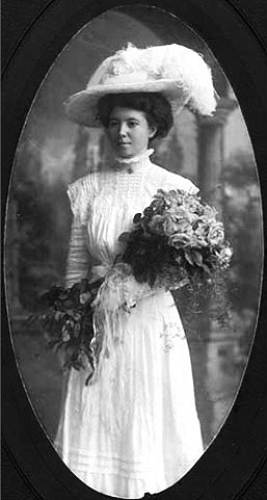
13 Lela (Haunstein) Clark - Wife of Ed Clark She was a sister to Lizzie Hauenstein, mother of Bamber Wright. He was the same Edward P. Clark that worked in the courthouse as a clerk and has his name on the cornerstone of the old Tuscumbia jail (photos 14 and 15).
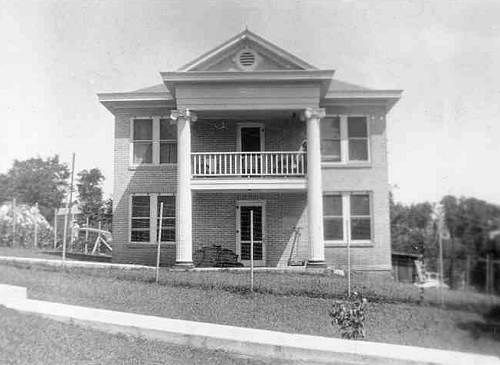
14 Miller County Jail
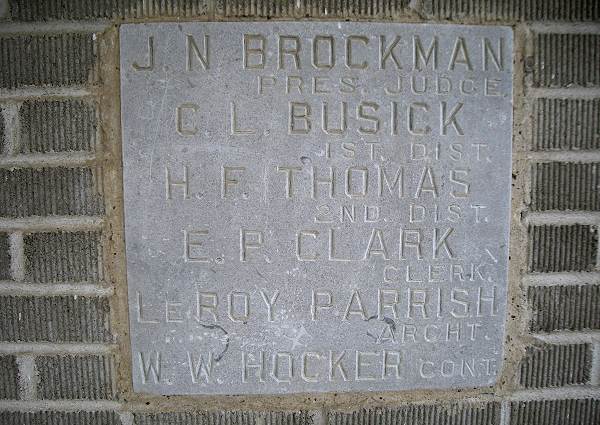
15 Names engraved on South wall of Jail His dad was my great-grandfather Billy Clark who also worked in the courthouse as a deputy county clerk to Uncle Charley Clarke. John Bear was a judge at that time. The name Clark means "clerk" which is fitting for the type of work that they did.
Here is a photo of Edward Clark in his office at the Courthouse (photo 15a):
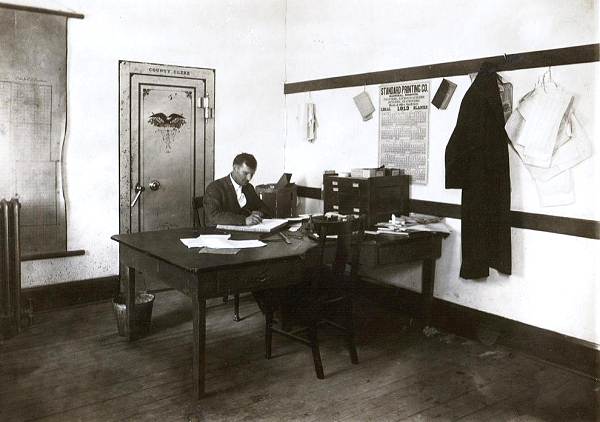
15a Edward P. Clark - 1913 And here is a photo of Edward Clark with some of the prominent young ladies of Tuscumbia at the time (photo 15b):
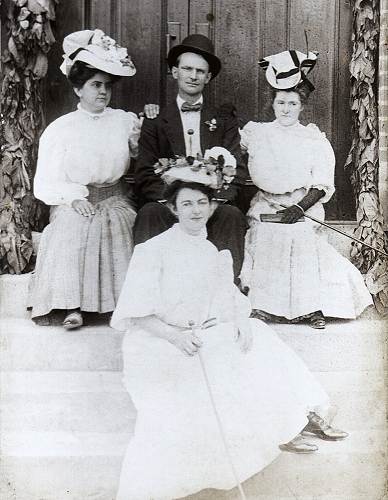
15b Edward P. Clark and Friends Mike listed their names as follows:
Back row is Rosa (James) Fendorf, wife of Fred Fendorf and mother of Helen Phillips.
Uncle Ed Clark, my grandfathers brother.
Myrtle (Burris) Clarke, wife of Charley Clarke, Jr.
Seated in front is Mary (Kouns) Hauenstein, daughter of Dr. Kouns, and wife of Fred Hauenstein.
And Mike made the following comment:
“Uncle Ed Clark was quite a ladies man! All of the women liked him!”
A note about Aunt Lela. She died of TB. She had a daughter named Genevieve Clark that also died of TB.
In the photo above of the County Court taken in 1909, you will notice that Edward P. Clark is standing next to Will Bear probably indicating they were friends. Here are Mike’s comments about Will:
I have an old picture of Will Bear. He was a boyfriend to my great-aunt. The picture was taken about 1910. He must have been born during the early 1880's. They didn't marry, she married Elmer Scott, my grandmother's brother.
Here is Mike’s photo of Will Bear standing next to Mike’s great uncle, Edward P. Clark (photo 16):

16 Will Bear and Great Uncle Ed Clark Will Bear was the son of John Bear, who was sitting on the steps in the 1901 photo of the County Court above (photo 08). John Bear was a brother to my great grandfather, David C. Bear. Notice that in the photo of Will and Ed together, Will is taller. However, in the group 1909 photo, Will and Ed’s height is more even. But look closely and you will see that Will’s legs and feet are standing a step lower than are Ed’s feet, which cannot be seen on the same step but on the step above. Some of the Bear family were quite tall, and John and his son Will probably were the tallest, except for Clarence Bear, John’s nephew.
One of Tuscumbia’s finest homes was built by Charles Clarke, Mike’s great uncle by marriage who was married to his grandfather’s sister, Mattie Clark. Here are Mike’s comments about the home:
Uncle Charley Clarke built his home about the same time as Bob Marshall's. They did both look a lot alike. Uncle Charley was a river ferryman way back when Bob Marshall was a steamboat captain. This photo of Uncle Charley’s home shows how it looked before he built a retaining wall around it (photo 17).
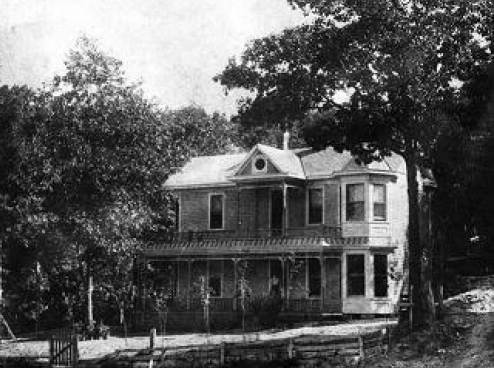
17 Home of Charles H. Clarke Eventually, Uncle Charley and his family moved to Kansas City shortly after 1910 and he sold his home to Uncle Ed Clark (his brother-in-law).
This next photo features Genevieve Clark standing on the steps (photo 18):
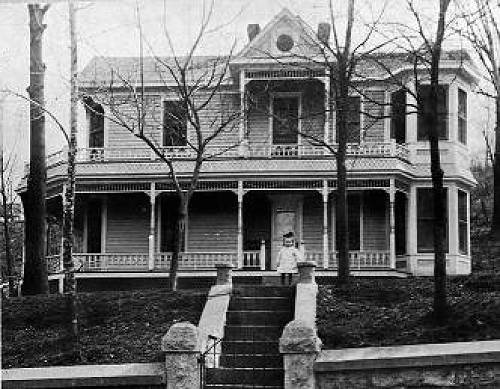
18 Home of Edward P. Clark who purchased it from Charles Clarke Genevieve was a daughter of Uncle Ed Clark and Aunt Lela (Hauenstein). It was a beautiful home which at one time was painted pink and white. I have been in it and have the floor plan explaining all about the rooms.
Unfortunately, the Clarke home no longer is standing having burned quite a few years ago. The concrete entrance and steps barely can be seen through the weeds and underbrush (photo 19).
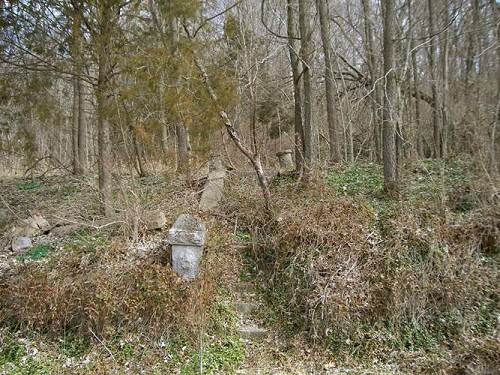
19 Front steps going up to House Here are the corner posts (photos 20 and 21):
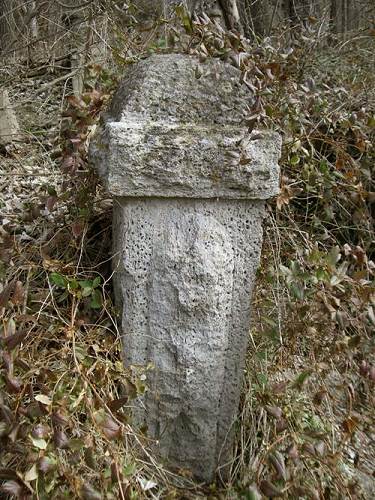
20 Front corner post of Stairs
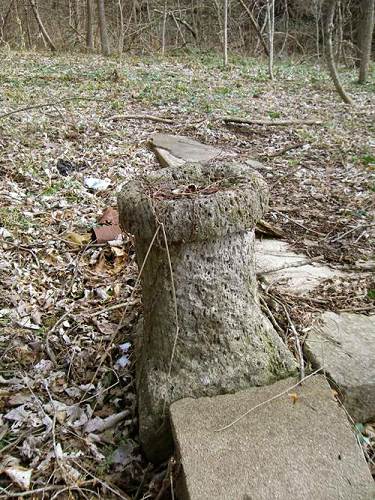
21 Back corner post of Stairs Here is a photo of the south corner of the stone wall (photo 22):
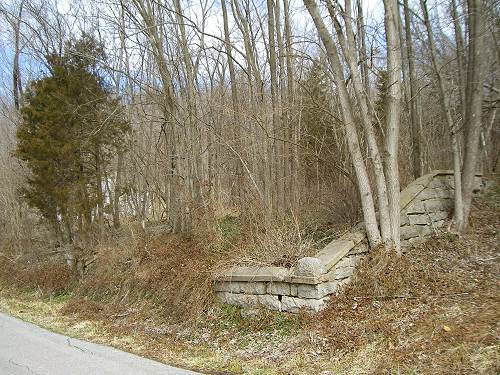
22 South Corner The location of the Clarke home was in what was known as the Clarke Addition on Versailles Avenue. In this recent map of Tuscumbia taken from the Vernon Publishing Company website, you will see Clark Street intersecting with Versailles Avenue (photo 23).
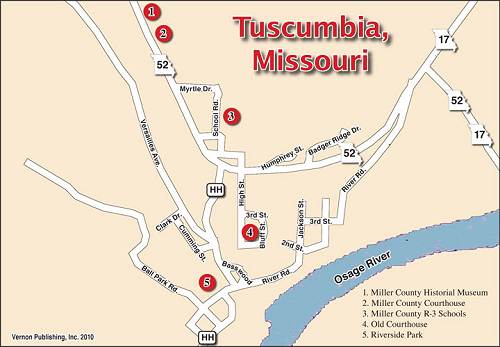
23 Tuscumbia City Map
Click image for larger viewThe Clarke home was on the hillside on the east side of Versailles Avenue just a short distance south of Clark Street. Here is an old map of Tuscumbia which shows the Clarke Addition in color pink on the map (photo 24).
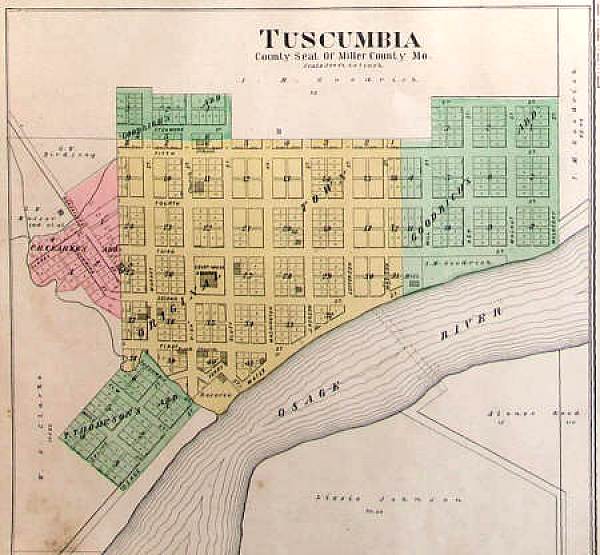
24 Old Map of Tuscumbia Unfortunately, the map doesn’t reproduce clearly enough to read the street names. My mother made a drawing of the names of the owners of homes on Versailles Avenue during the 1920’s (photo 25).

25 Map of Houses on Possum Trot
Click image for larger viewIn her day, and even now, most people called Versailles Avenue by another name, “Possum Trot.” On the north side of Possum Trot in her sketch you will see one of the homes is listed as owned by Jim Spearman. This is the original Clarke home.
By way of comparison here is an old photo of the Robert Marshall home (photo 26):
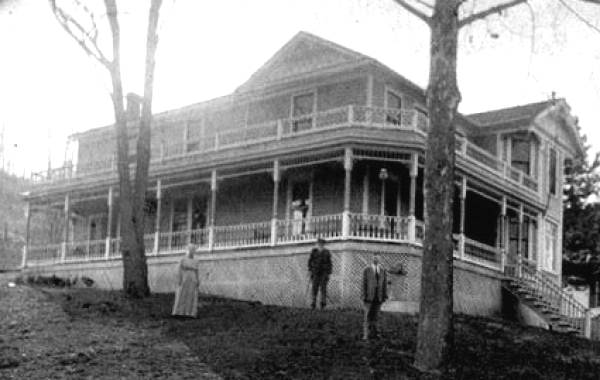
26 Marshall Home
Emma (Hauenstein) Marshall - Left, Wm. Hauenstein Sr. - Middle, Bob Marshall - Right And another photo of Robert Marshall himself (photo 27):
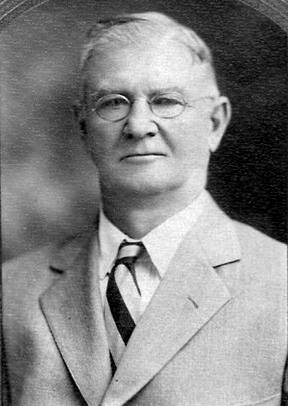
27 Captain Bob Marshall This home was located in Goosebottom at the intersection of HH and the City Park road. You can see this location at the bottom of the current map of Tuscumbia (photo 23 above).
Mike comments about the Marshall home:
Bob Marshall had his home built in Tuscumbia to look like one of his steamboats. He lived there until he moved to Eldon to live with his niece Vivian (Fogleman) Caldwell. I knew Vivian well and used to interview her about Tuscumbia and her family.
As mentioned above, Thomas Scott, former Missouri State Senator from Miller County, was Mike’s 2nd great grandfather (photo 28).
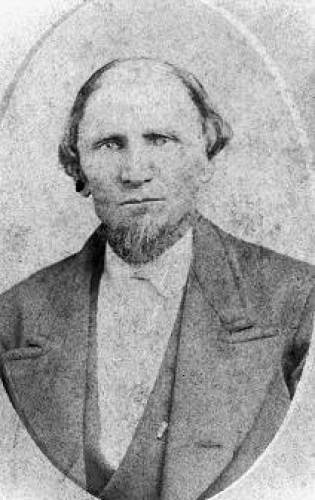
28 Thomas Scott He was married to America Stilwell Scott (photo 29).
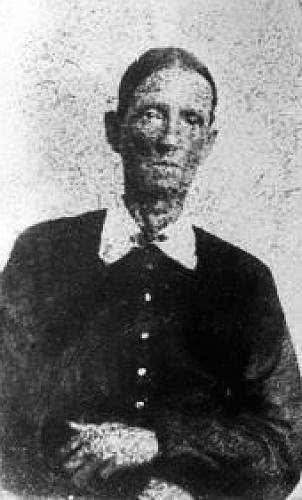
29 America (Stilwell) Scott - Wife of Thomas Scott Thomas was a very important and well known Miller County figure of the 1800’s. He was one of only five men to have served as a resident State Senator. The others were: James H. Todd 1869, 1871; Frank DeVilbliss 1905, 1907; W. S. Allee 1909-1915; and C.R. (Ted) Hawkins 1945 to 1959.
Gerard Schultz included a short biography of Thomas Scott in his book, History of Miller County written in 1933:
Thomas Scott was a prominent figure in Miller County politics during the period of the Civil War. He was state senator from 1858 to 1862, state representative from 1863 to 1864, a member of the county court from 1860 to 1862, and a justice of the peace. As a member of the convention in 1861 he was active in behalf of the Union. In 1872 he supported the Liberal Republican Party. He lived on a farm on the Osage River, about three miles upstream from Tuscumbia. He practiced law at Tuscumbia with Jacob Gantt as his partner.
It is interesting to note that he had taken a part in the famous gold rush of 1849 and spent the later years of his life in California. He was an active member of the Baptist Church and the Masonic Order. Senator Scott was born in Tennessee, December 8, 1816, and died near Tuscumbia, August 30, 1887.
Mike Wieneman reported to me that most of the Miller County gold seekers went to the town of Placerville, California, originally known as “Hangtown.” Here is a photo of a sign outside the town giving some history (photo 30):
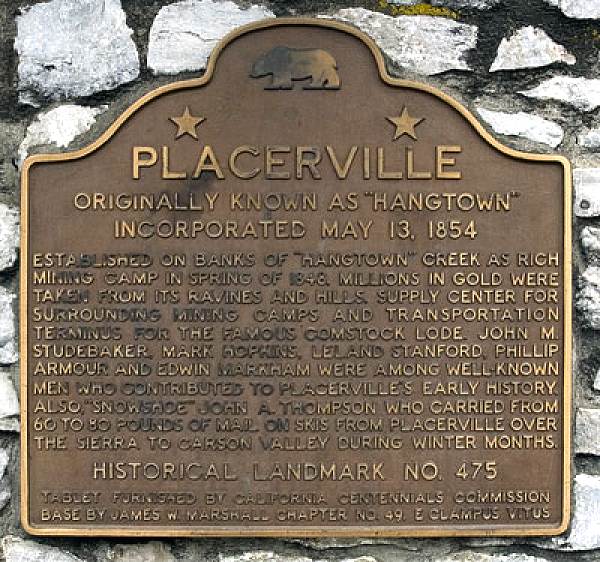
30 Placerville, California Sign He believes this is where Thomas Scott spent some time seeking gold.
Mike also told me the Scott Cemetery near Tuscumbia was named for the parents of Thomas Scott. They were Thomas and Sarah (Mahurin) Scott, early Miller County residents. The cemetery was on their land; however, no tombstones are present for them, only a couple of rock markers. Another interesting piece of information about Senator Scott is that he was the grandfather of the very well respected Miller County and Eldon educator, Thomas Everett Vaughan (photo 31).
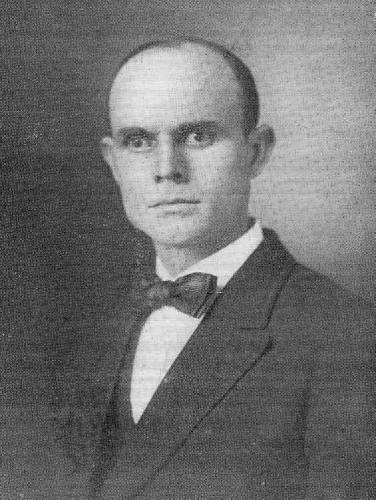
31 Thomas Everett Vaughan Professor Vaughan’s parents were Wilson and Rachel Jane (Scott) Vaughan. His mother Rachel Jane was the daughter of Thomas and America (Stilwell) Scott. T.E. Vaughan, as he was often called, married Emma Blackburn. Her mother was Lena Marshall, a sister to Bob Marshall.
Here is an old photo of the Wilson Vaughan family, absent Rachel Jane (photo 32):
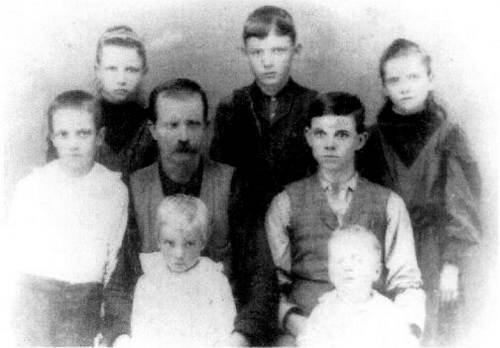
32 Tressa, Theron, Jacob, Ethel Zene, Eric Lyman, Wilson Milton,
Thomas Everett, Lafayette Cordell and Floyd Estel Vaughan Wilson's first wife and last wife were descendants of the Scott family, Rachel Jane Scott and Destia Lee Dobson.
You can read about Thomas Everett Vaughan, the famous educator and grandson of Thomas Scott, at a previous Progress Notes.
To visit the Scott Cemetery take Hwy 52 to HH at Tuscumbia, and go 3.3 miles to gravel and continue .4 miles to the cemetery. This cemetery is well tended and fenced.
I want to thank Mike Wieneman for the time he took to write the history of his Clark family heritage as well as supplying almost all the photos accompanying it. As you can understand now after reading it, Mike certainly has a number of deep roots in Tuscumbia and it is so wonderful that he has had the willingness to share his memories and photo collection with us! Mike has graciously offered his email for readers who want to communicate with him: mike9925@aol.com.
As we draw closer this year to the opening of the new bridge across the Osage River, more attention is being paid to the history of the river and its bridges. During the day of the opening of the present bridge in 1933 a huge celebration was held. You can read the full story of that event on our website.
One of the presentations on that day was a speech by historian Gerard Schultz on the topic of the history of transportation on the Osage River. The speech was printed in the Autogram and I will present it here:
Miller County Autogram
November 9, 1933
Gerard Schultz
(Address delivered at Tuscumbia Bridge Dedication by Mr. Gerard Schultz, Professor of History and German, Iberia Junior college, and author of History of Miller County.)
It is my purpose to sketch briefly the development of transportation in Miller County. It is not an easy task. It sometimes requires a long search to find significant facts but once found these facts throw light on the hardships which faced our predecessors when they found it necessary to travel inland through unsettled or developed land. Travel was by foot or horseback and thirty miles in a day was the maximum to be expected.
The first historic roads in this county were two Indian trails. One trail followed the high ground along the north side of the Osage River; the other trail entered the county south of Iberia and crossed the Osage River in the vicinity of the Osage Dam (at the time this was written by Professor Schultz, the Bagnell Dam had not been assigned an official name) (photo 33).
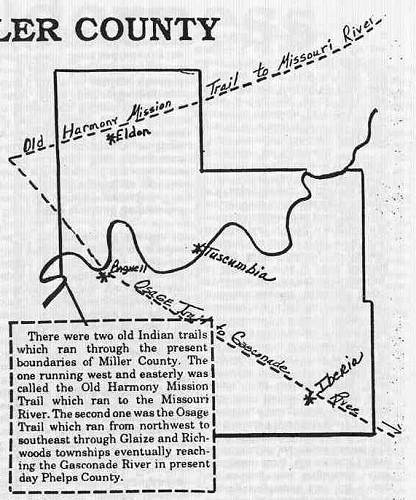
33 Indian Trails In 1719 the latter trail was followed by Du Tisne, a French explorer and the first white man known to see what is now Miller County.
Even in the days when the region was still the hunting ground of the Osage Indians the river which bears their name was an important highway of trade and travel. In 1804 the traffic in furs on the river was estimated at $28,000. Passing up and down the river, the French traders and trappers gave names to all of the larger streams in the county.
In 1806 the celebrated expedition of Zebulon Pike ascended the Osage (photo 37).
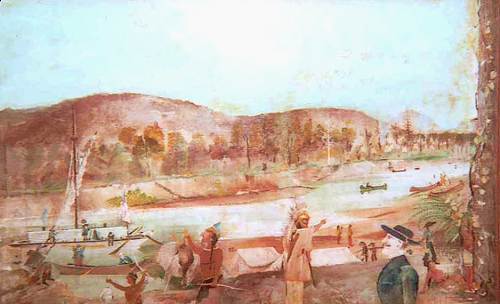
37 Pike's Landing at Tuscumbia as painted by Tuscumbia painter John Wright ‘But other means of travel were to come; for once there were settlers there must be found a safe way to carry mail and passengers. The first road in this county led across the Osage River at Tuscumbia. It extended from Jefferson City to Waynesville. Mail began to be carried over this route on February 1, 1837…six days before Miller County was created by the General Assembly of the State of Missouri. For many years the mail was carried over this route once a week by men on horseback. The post rider started from Jefferson City in the morning and made his way southward to the Osage River where he crossed on a ferry at Tuscumbia and then proceeded to Waynesville which he reached after two days of hard riding (photo 38).
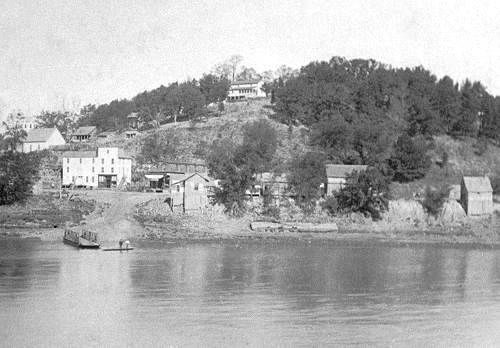
38 Ferry Landing at Tuscumbia In 1837 the trail of the post rider was widened into a carriage road. The stage coach left Jefferson City for Tuscumbia every Monday and Friday. It was large enough to carry three passengers and the mail.
Travelers were not obliged to rely upon the stagecoach alone, however. Steamboats began to ply the Osage in the late thirties. The Osage is a winding stream with many deep curves of nearly parallel sides. The story is told that travelers often remarked that no owls were sighted or heard along the river. The explanation given was that when the first steamboat made its way up the Osage River the “owls had turned their heads around so far to follow it around the curves that they twisted them off and they fell to the ground!”
Whether or not this story is true, the steamboats were exceedingly useful. Prior to the coming of the railroads almost all the freight of this region was carried by steamboats. The steamers Frederick and the John R. Hugo, owned by Captain Robert M. Marshall of Tuscumbia, were prominently identified with the carrying trade on the Osage River. They did a business of no mean proportions. In one year the Hugo carried 115,000 sacks of wheat and the Frederick 90,000 sacks in addition to much live stock, country produce, lumber, ties, general merchandise, lead and other minerals (photos 39, 40 and 41 of Hugo, Frederick and both).

39 Hugo
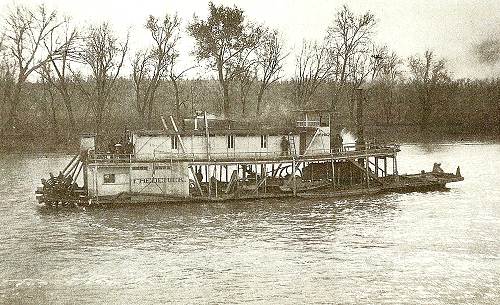
40 Frederick on the Osage
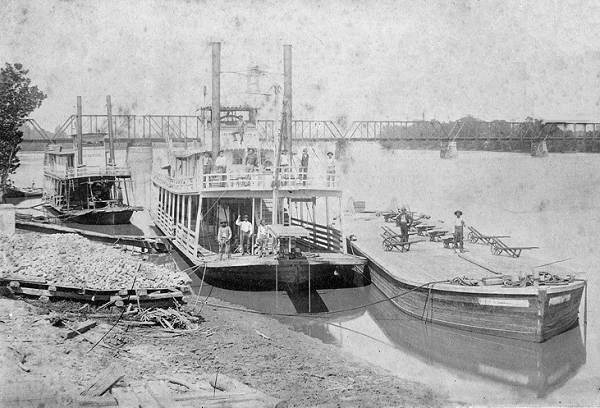
41 Frederick and Hugo - Osage City - Choking Stump The first railroad to come to Miller County is the spur from the St. Louis-Kansas City route of the Missouri Pacific. When it was built in 1881-1882, it was known as the Jefferson City, Lebanon and Southwestern. Twenty years later the track of the road now known as the Chicago, Rock Island and Pacific was laid across the northern part of the county. This railroad made Eldon a division point and has been an important factor in the rapid growth of the town (photo 42).
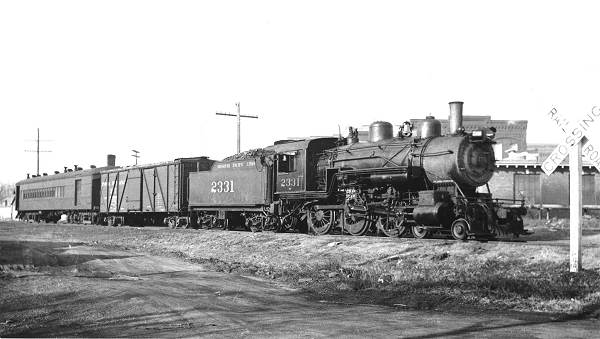
42 Missouri Pacific Engine and Cars at Depot in Eldon In recent years, by far the most important development in the county’s system of transportation has been the building of federal, state and supplementary highways. One of these is a paved road, and the others are well graveled and kept in good condition throughout the year (photos 43 and 44).
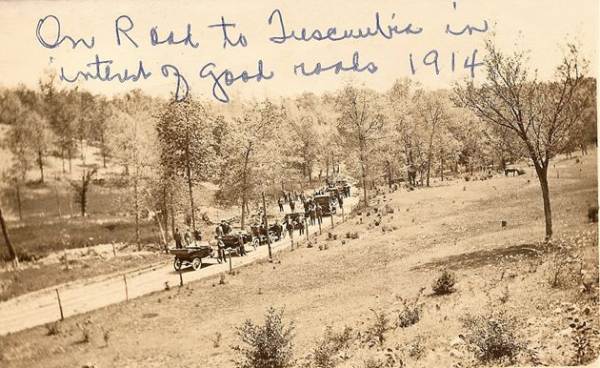
43 Good Roads Parade
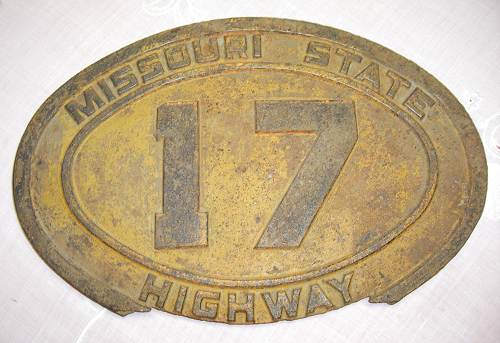
44 Old Highway 17 Road Sign Another important improvement has been the building of bridges. About fifty years ago, there were no bridges in this county and streams had to be forded, but a number of ferries were operated on the rivers (see photo 38 above). Licenses for ferries were established and rates fixed by the County Court. The first one to keep a ferry across the Osage River at Tuscumbia was Cornelius Davidson in 1837. He was to charge the following rates: wagon and six horses, one dollar and fifty cents; wagon and four horses: one dollar and twenty five cents; wagon and two horses, one dollar; four wheel carriages: seventy five cents; gig and horse, twenty five cents; single horse, twelve and one half cents; footmen, six and one fourth cents; cattle, per head, ten cents; hogs and sheep, per head, three cents; baggage per cwt, ten cents. At one time during the Civil War the Stars and Bars floated on one side of the ferry landing at Tuscumbia and the Stars and Stripes on the other side. The ferry boat at this time was a large “flat bottomed” boat and was propelled across the river by two large oars called “sweeps”, one on each side. The ferryman was summoned by a loud call or shout.
It was a noteworthy event when, as a result of private enterprise the first bridge across the Osage River in this county was completed. At the occasion of its dedication on August 5, 1905, the main address was made by the Honorable L.N. Musser (photo 45).
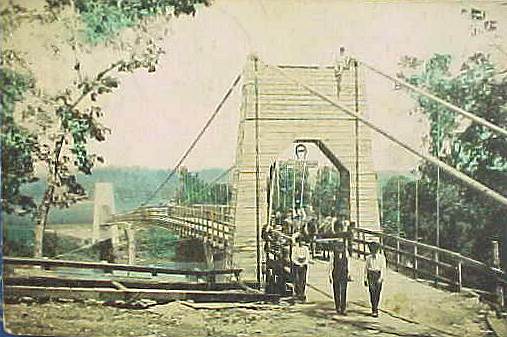
45 Tuscumbia Swinging Bridge This bridge has now been replaced by the modern concrete and steel structure which has been dedicated today (photo 46).
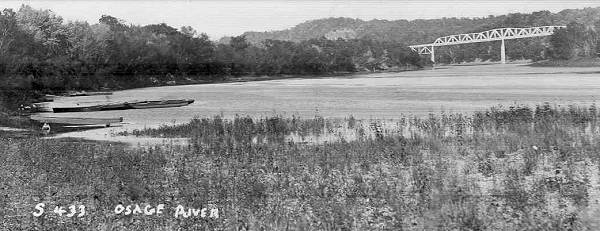
46 Osage River Bridge Miller County is justly proud of this new structure; it will mean much to future economic and social development.
The above discussion by Gerard Schultz included a paragraph about the significant road improvements that had occurred just over a few short years before the 1933 bridge was built. Even then, though, most Miller County roads were not paved or even graveled. Over time we have, of course, witnessed the construction of numerous paved highways in the county including a four lane limited access Highway 54. However, in the last year, due to inclement weather and a shortfall of tax revenue as a result of the recession, non paved roads are becoming nearly impassable, especially after a hard rain, and even the paved roads are in need of repair. So the other day when I stopped at Orscheln’s Store in Eldon I saw that one of the customers had decided to come by horse and wagon (photo 47).
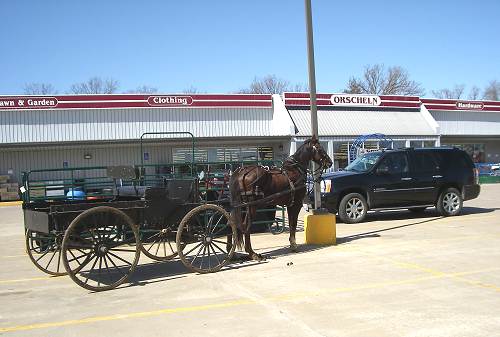
47 Horse and Wagon at Orscheln's Saves gas and car expense, insurance premiums, and you most likely won’t get stuck in a muddy road if you travel by horse and wagon! Of course, I knew that the horse and wagon most likely belonged to one of the members of the Mennonite community west of Eldon, but the thought did occur to me that sometime, maybe sooner than we think, some of the rest of us may be thinking about buying a horse and wagon. But you know, I just learned that even they aren’t cheap anymore. Several thousand dollars I was told!
That’s all for this week.
 Joe Pryor
Previous article links are in a dropdown menu at the top of all of the pages.
|

